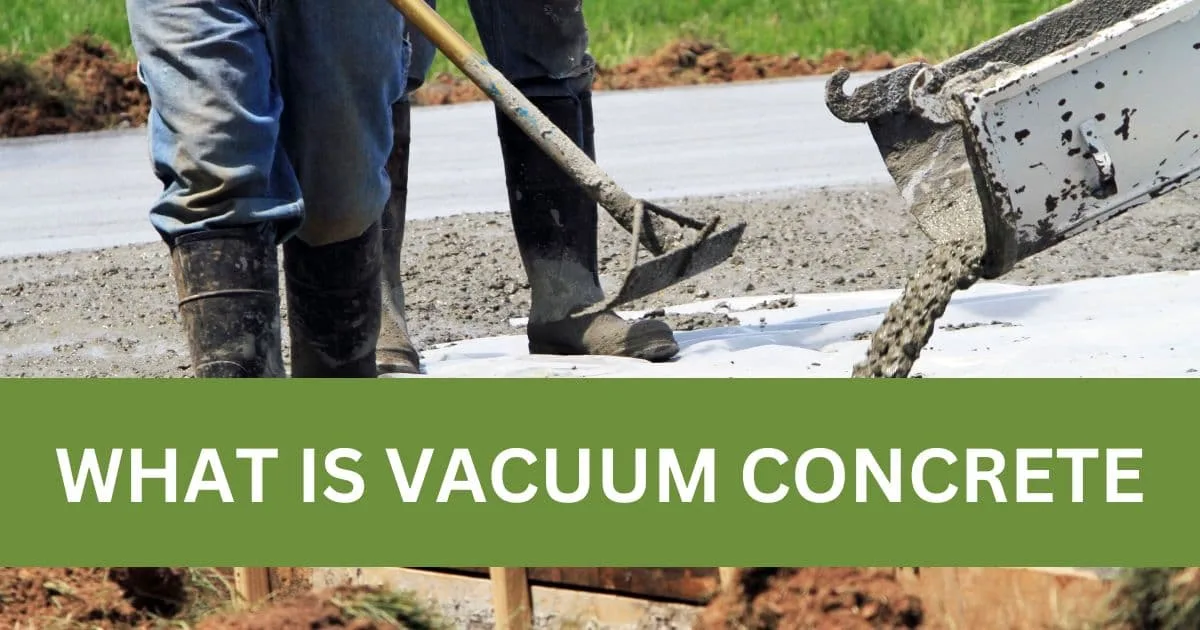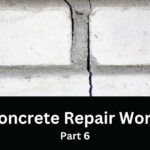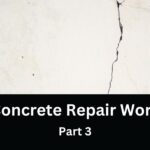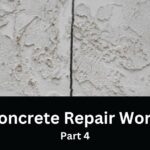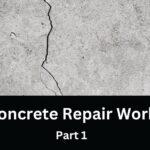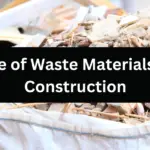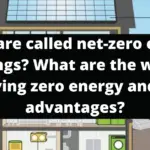Vacuum concrete is a technique where excess water is removed from freshly laid concrete using a vacuum pump, enhancing the concrete’s strength, durability, and surface finish.
This article delves into the need for vacuum concrete and its pros and cons. also vacuum concrete processes, including dewatering procedures and applications.
Table of Contents
The Need for Vacuum Concrete
The fundamental requirement of a water-cement ratio below 0.38 for the chemical reaction of cement with water is a core aspect of concrete composition. However, in practice, a higher ratio is adopted to maintain the workability of concrete, which is crucial for its placement and consolidation.
This increased water-cement ratio traditionally comes at the expense of strength, creating a dichotomy between workability and high strength. Vacuum concrete emerges as a potent solution to this conundrum, effectively bridging the gap between the opposing necessities of workability and high strength.
By employing a vacuum pump to extract excess water post-placement, vacuum concrete maintains a desirable workability while simultaneously enhancing the strength and durability of the resulting structure, thus addressing a vital need in the construction sector.
Advantages of Vacuum Concrete
- Accelerated Strength Gain:
- Vacuum concrete facilitates early strength gain, allowing for quicker demolding and expedited construction schedules.
- The final strength of concrete is escalated by about 25%, enhancing both compressive and tensile strength.
- Enhanced Durability and Density:
- The reduction in water content through vacuum dewatering leads to a denser, more durable structure with less permeability.
- The durability and density of vacuum concrete are further improved with a notable reduction in voids.
- Improved Workability and Bonding:
- Achieves higher workability alongside increased strength, facilitating easy bonding with underlying concrete by about 20% according to the research gate [Vacuum Dewatering During Concreting ]
- Improved Surface Finish:
- The process yields a smooth, high-quality surface finish, minimizing the need for further surface treatments.
- The surface of vacuum concrete is pitting-free, and the top layer exhibits high resistance to abrasion, making it suitable for structures in contact with rapidly flowing water.
- Reduced Shrinkage:
- Vacuum dewatering significantly curtails shrinkage, reducing the likelihood of cracks and improving structural integrity.
- Cost Efficiency:
- The accelerated construction pace, reduced need for repairs, and earlier formwork removal translate to lower overall costs, despite higher initial costs due to specialized equipment.
- Reduced Curing Time:
- The curing period is significantly shortened; a 1-week curing period is reduced to 3 days and a 4-week period can be brought down to 1 week.
- Efficient Compaction and Finishing:
- Compaction is simplified and more effective, allowing for earlier final finishing of the concrete floor.
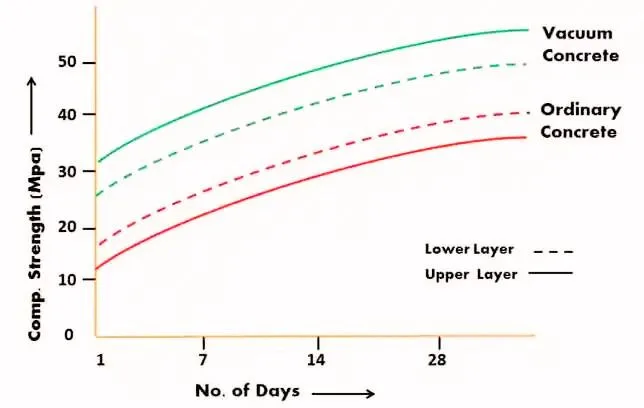
Disadvantages of Vacuum Concrete
- High Initial Costs:
- The necessity for specialized equipment and power for dewatering significantly increases the initial project expenditure.
- Specialized Equipment Requirement:
- Specific equipment is essential for the vacuum dewatering process, contributing to the higher initial costs.
- Skilled Labor Dependency:
- The process requires skilled laborers proficient in managing the dewatering process, which may be challenging to find or train.
- Power Consumption:
- Power is consumed during dewatering, adding to the operational costs.
- Restricted Water-Cement Ratio:
- Vacuum concrete is less suitable for concrete with a water-cement ratio of less than 0.4, limiting its versatility.
- Increased Porosity Concerns:
- The porosity of the concrete could allow water, oil, and grease to seep through, potentially weakening the concrete over time.
Related: Why is concrete weak in tension
Vacuum Concrete Process
Delving into the vacuum concrete process unveils a meticulous procedure aimed at enhancing the concrete’s performance by reducing the effective water-cement ratio. This is achieved through a dewatering technique which significantly improves the surface of the concrete where it’s needed the most. Below is a comprehensive walkthrough of the dewatering procedure and the essential equipment utilized.
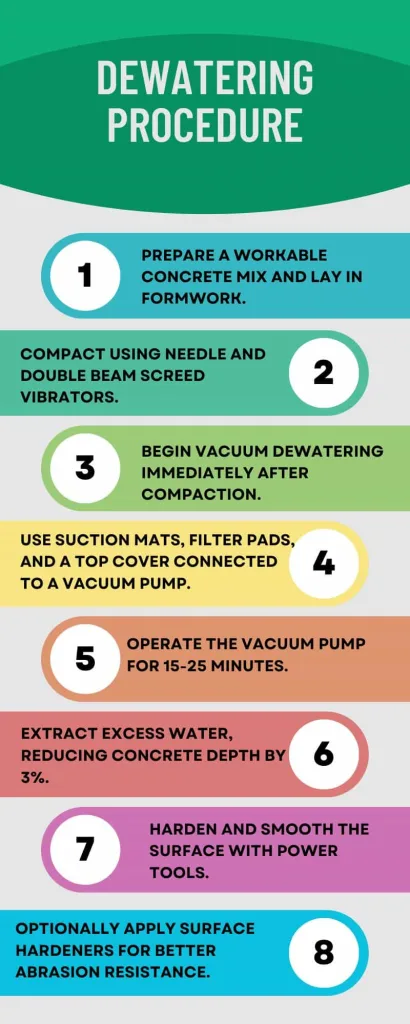
Dewatering Procedure
- Preparation and Placement:
- A concrete mix of sufficient workability is prepared and laid in the formwork.
- The surface is initially compacted using a needle vibrator, followed by further compaction with a double beam screed vibrator to obtain a smooth surface.
- Initiation of Vacuum Dewatering:
- Dewatering commences immediately after compaction using vacuum equipment.
- Suction mats and filter pads are rested upon the fresh concrete, leaving a 4-inch filter cover exposed on all sides.
- A top cover is placed on the filter pads and connected to a vacuum pump through a suction hose.
- Vacuum Pump Operation:
- The vacuum pump, typically ranging between 5 to 10 horsepower, is operated for about 15-25 minutes, contingent on the concrete floor thickness.
- Prolonged pumping beyond 30 minutes is avoided as it results in an insignificant reduction in water content.
- Water Extraction and Compaction:
- The atmospheric pressure compresses the concrete, suctioning out surplus water through fine wire gauge or muslin cloth.
- Water content is lowered by 15-25% of the original amount, with a consequent 3% reduction in concrete layer depth.
- Finalization and Surface Treatment:
- The dewatered concrete is compacted and dried until it no longer leaves footprints when walked over, indicating adequate dewatering and readiness for finishing.
- The surface is further hardened and smoothed using a power trowel and power float, which also assists in eliminating capillaries or channels formed during water suction.
- Surface Hardeners:
- Optionally, surface hardeners can be applied to enhance the abrasion resistance of the concrete, a step facilitated by the dewatered surface’s ideal conditions.
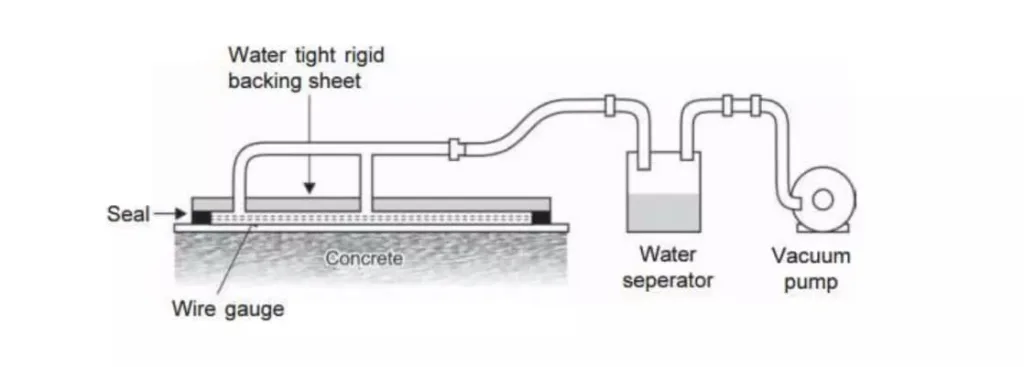
Equipment Used in the Dewatering Process
The table below encapsulates the key equipment involved in vacuum dewatering of concrete:
| Equipment | Description |
| Formwork | Preparing formwork using ms channels for safe operation of stopper and screed vibrator. |
| Vacuum Pump | Electric motor-driven pump (5-10 HP) for extracting excess water. |
| Filtering Pad | With a minimum size of 90cm x 60cm, it includes a backing piece and rubber seal. |
| Suction Mat | Placed on a concrete surface, fixed on fine filter pads to prevent cement slurry with water. |
| Power Trowel | Utilized post-suction to improve concrete condition by filling cracks via vibration. |
| Power Float | Employed for final surface finishing, enhancing concrete strength. |
| Double Beam Screed Vibrator | A 12.5 kg electric-powered vibrator for compacting concrete. |
Applications of Vacuum Concrete
Vacuum concrete finds its utility in a myriad of applications within the construction domain, owing to its accelerated strength gain and enhanced durability. Below are some primary applications:
- Flatwork: Utilized in constructing large flat surfaces like industrial floors, runways, and parking lots due to its superior finish and strength.
- Bridge Decks: Ideal for bridge deck constructions, ensuring a durable and smooth surface.
- Precast Elements: Expedited strength gain makes it suitable for precast concrete elements, accelerating the production schedule.
- Water Tanks and Reservoirs: Ensures water-tightness and durability, essential for long-term performance.
- Marine Structures: Resilience to harsh marine environments makes vacuum concrete a preferred choice for piers, jetties, and other marine structures.
- Repair Works: Effective in repair and rehabilitation projects, providing a robust and lasting solution.
- High-Rise Buildings: Utilized in high-rise buildings for creating strong and durable structural elements.
Conclusion.
Vacuum concrete efficiently resolves the construction dilemma between workability and strength through a precise dewatering process, enhancing the water-cement ratio. Despite initial costs, its long-term benefits, like reduced curing time and efficient compaction, outweigh the investment. Its versatility across various construction domains like flatwork, bridge decks, and marine structures showcases its potential to modernize construction practices.
